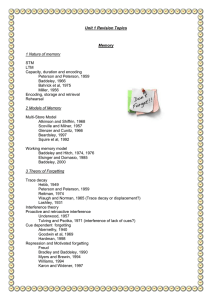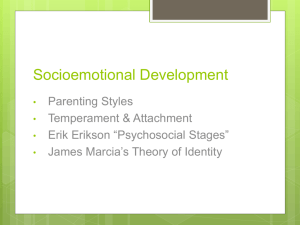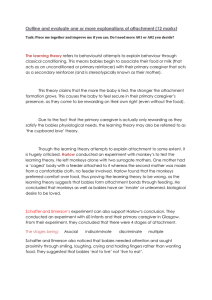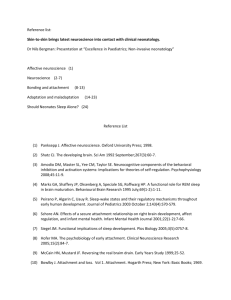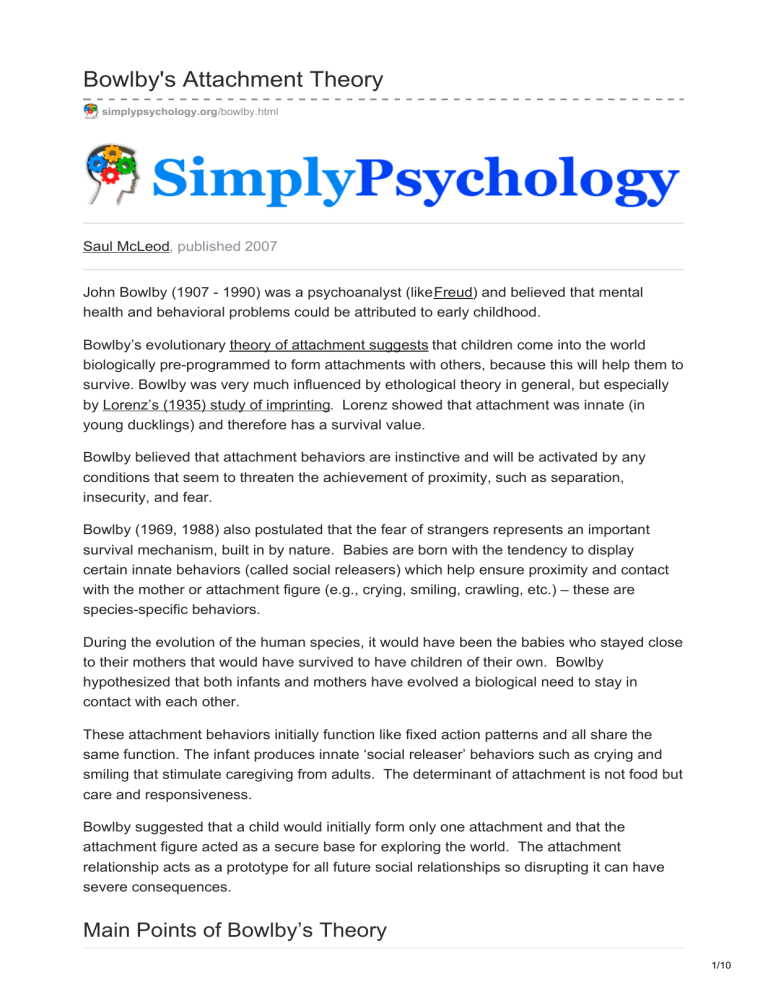
Bowlby's Attachment Theory simplypsychology.org/bowlby.html Saul McLeod, published 2007 John Bowlby (1907 - 1990) was a psychoanalyst (like Freud) and believed that mental health and behavioral problems could be attributed to early childhood. Bowlby’s evolutionary theory of attachment suggests that children come into the world biologically pre-programmed to form attachments with others, because this will help them to survive. Bowlby was very much influenced by ethological theory in general, but especially by Lorenz’s (1935) study of imprinting. Lorenz showed that attachment was innate (in young ducklings) and therefore has a survival value. Bowlby believed that attachment behaviors are instinctive and will be activated by any conditions that seem to threaten the achievement of proximity, such as separation, insecurity, and fear. Bowlby (1969, 1988) also postulated that the fear of strangers represents an important survival mechanism, built in by nature. Babies are born with the tendency to display certain innate behaviors (called social releasers) which help ensure proximity and contact with the mother or attachment figure (e.g., crying, smiling, crawling, etc.) – these are species-specific behaviors. During the evolution of the human species, it would have been the babies who stayed close to their mothers that would have survived to have children of their own. Bowlby hypothesized that both infants and mothers have evolved a biological need to stay in contact with each other. These attachment behaviors initially function like fixed action patterns and all share the same function. The infant produces innate ‘social releaser’ behaviors such as crying and smiling that stimulate caregiving from adults. The determinant of attachment is not food but care and responsiveness. Bowlby suggested that a child would initially form only one attachment and that the attachment figure acted as a secure base for exploring the world. The attachment relationship acts as a prototype for all future social relationships so disrupting it can have severe consequences. Main Points of Bowlby’s Theory 1/10 1. A child has an innate (i.e., inborn) need to attach to one main attachment figure (i.e., monotropy). Although Bowlby did not rule out the possibility of other attachment figures for a child, he did believe that there should be a primary bond which was much more important than any other (usually the mother). Bowlby believes that this attachment is qualitatively different from any subsequent attachments. Bowlby argues that the relationship with the mother is somehow different altogether from other relationships. Essentially, Bowlby (1988) suggested that the nature of monotropy (attachment conceptualized as being a vital and close bond with just one attachment figure) meant that a failure to initiate, or a breakdown of, the maternal attachment would lead to serious negative consequences, possibly including affectionless psychopathy. Bowlby’s theory of monotropy led to the formulation of his maternal deprivation hypothesis. The child behaves in ways that elicits contact or proximity to the caregiver. When a child experiences heightened arousal, he/she signals their caregiver. Crying, smiling, and, locomotion, are examples of these signaling behaviors. Instinctively, caregivers respond to their children’s behavior creating a reciprocal pattern of interaction. 2. A child should receive the continuous care of this single most important attachment figure for approximately the first two years of life. Bowlby (1951) claimed that mothering is almost useless if delayed until after two and a half to three years and, for most children, if delayed till after 12 months, i.e., there is a critical period. If the attachment figure is broken or disrupted during the critical two year period, the child will suffer irreversible long-term consequences of this maternal deprivation. This risk continues until the age of five. Bowlby used the term maternal deprivation to refer to the separation or loss of the mother as well as failure to develop an attachment. The underlying assumption of Bowlby’s Maternal Deprivation Hypothesis is that continual disruption of the attachment between infant and primary caregiver (i.e., mother) could result in long-term cognitive, social, and emotional difficulties for that infant. The implications of this are vast – if this is true, should the primary caregiver leave their child in day care, while they continue to work? 3. The long-term consequences of maternal deprivation might include the following: 2/10 • delinquency, • reduced intelligence, • increased aggression, • depression, • affectionless psychopathy Affectionless psychopathy is an inability to show affection or concern for others. Such individuals act on impulse with little regard for the consequences of their actions. For example, showing no guilt for antisocial behavior. 4. Robertson and Bowlby (1952) believe that short-term separation from an attachment figure leads to distress (i.e., the PDD model). They found three progressive stages of distress: Protest: The child cries, screams and protests angrily when the parent leaves. They will try to cling on to the parent to stop them leaving. Despair: The child’s protesting begins to stop, and they appear to be calmer although still upset. The child refuses others’ attempts for comfort and often seems withdrawn and uninterested in anything. Detachment: If separation continues the child will start to engage with other people again. They will reject the caregiver on their return and show strong signs of anger. 5. The child’s attachment relationship with their primary caregiver leads to the development of an internal working model (Bowlby, 1969). This internal working model is a cognitive framework comprising mental representations for understanding the world, self, and others. A person’s interaction with others is guided by memories and expectations from their internal model which influence and help evaluate their contact with others (Bretherton, & Munholland, 1999). 3/10 Around the age of three, these seem to become part of a child’s personality and thus affects their understanding of the world and future interactions with others (Schore, 2000). According to Bowlby (1969), the primary caregiver acts as a prototype for future relationships via the internal working model. There are three main features of the internal working model: (1) a model of others as being trustworthy, (2) a model of the self as valuable, and (3) a model of the self as effective when interacting with others. It is this mental representation that guides future social and emotional behavior as the child’s internal working model guides their responsiveness to others in general. 44 Thieves Study (Bowlby, 1944) John Bowlby believed that the relationship between the infant and its mother during the first five years of life was most crucial to socialization. He believed that disruption of this primary relationship could lead to a higher incidence of juvenile delinquency, emotional difficulties, and antisocial behavior. To test his hypothesis, he studied 44 adolescent juvenile delinquents in a child guidance clinic. Aim: To investigate the long-term effects of maternal deprivation on people in order to see whether delinquents have suffered deprivation. According to the Maternal Deprivation Hypothesis, breaking the maternal bond with the child during the early stages of its life is likely to have serious effects on its intellectual, social and emotional development. Procedure: Between 1936 and 1939 an opportunity sample of 88 children was selected from the clinic where Bowlby worked. Of these, 44 were juvenile thieves and had been 4/10 referred to him because of their stealing. Bowlby selected another group of 44 children to act as ‘controls (individuals referred to the clinic because of emotional problems, but not yet committed any crimes). On arrival at the clinic, each child had their IQ tested by a psychologist who also assessed the child’s emotional attitudes towards the tests. At the same time a social worker interviewed a parent to record details of the child’s early life (e.g., periods of separation). The psychologist and social worker made separate reports. A psychiatrist (Bowlby) then conducted an initial interview with the child and accompanying parent (e.g., diagnosing affectionless psychopathy). Findings: More than half of the juvenile thieves had been separated from their mothers for longer than six months during their first five years. In the control group only two had had such a separation. He also found 14 of the young thieves (32%) showed 'affectionless psychopathy' (they were not able to care about or feel affection for others). None of the control group were affectionless psychopaths. Bowlby found that 86% of the ‘affectionless psychopaths’ in group 1 (‘thieves) had experienced a long period of maternal separation before the age of 5 years (they had spent most of their early years in residential homes or hospitals and were not often visited by their families). Only 17% of the thieves not diagnosed as affectionless psychopaths had experienced maternal separation. Only 2 of the control group had experienced a prolonged separation in their first 5 years. Conclusion: Bowlby concluded that maternal separation/deprivation in the child’s early life caused permanent emotional damage. He diagnosed this as a condition and called it Affectionless Psychopathy. According to Bowlby, this condition involves a lack of emotional development, characterized by a lack of concern for others, lack of guilt and inability to form meaningful and lasting relationships. 5/10 Evaluation: The supporting evidence that Bowlby (1944) provided was in the form of clinical interviews of, and retrospective data on, those who had and had not been separated from their primary caregiver. This meant that Bowlby was asking the participants to look back and recall separations. These memories may not be accurate. Bowlby designed and conducted the experiment himself. This may have lead to experimenter bias. Particularly as he was responsible for making the diagnosis of affectionless psychopathy. Another criticism of the 44 thieves study was that it concluded affectionless psychopathy was caused by maternal deprivation. This is correlational data and as such only shows a relationship between these two variables. Indeed, other external variables, such as family conflict, parental income, education, etc. may have affected the behavior of the 44 thieves, and not, as concluded, the disruption of the attachment bond. Thus, as Rutter (1972) pointed out, Bowlby’s conclusions were flawed, mixing up cause and effect with correlation. The study was vulnerable to researcher bias. Bowlby conducted the psychiatric assessments himself and made the diagnoses of Affectionless Psychopathy. He knew whether the children were in the ‘theft group’ or the control group. Consequently, his findings may have unconsciously influenced by his own expectations. This potentially undermines their validity. Evaluation of Bowlby’s Theory Bifulco et al. (1992) support the maternal deprivation hypothesis. They studied 250 women who had lost mothers, through separation or death, before they were 17. They found that loss of their mother through separation or death doubles the risk of depressive and anxiety disorders in adult women. The rate of depression was the highest in women whose mothers had died before the child reached the age of 6. Bowlby’s (1944, 1956) ideas had a great influence on the way researchers thought about attachment, and much of the discussion of his theory has focused on his belief in monotropy. Although Bowlby may not dispute that young children form multiple attachments, he still contends that the attachment to the mother is unique in that it is the first to appear and remains the strongest of all. However, on both of these counts, the evidence seems to suggest otherwise. Schaffer & Emerson (1964) noted that specific attachments started at about 8 months and, very shortly thereafter, the infants became attached to other people. By 18 months very few (13%) were attached to only one person; some had five or more attachments. Rutter (1972) points out that several indicators of attachment (such as protest or distress when attached person leaves) have been shown for a variety of attachment figures – fathers, siblings, peers and even inanimate objects. 6/10 Critics such as Rutter have also accused Bowlby of not distinguishing between deprivation and privation – the complete lack of an attachment bond, rather than its loss. Rutter stresses that the quality of the attachment bond is the most important factor, rather than just deprivation in the critical period. Bowlby used the term maternal deprivation to refer to the separation or loss of the mother as well as the failure to develop an attachment. Are the effects of maternal deprivation as dire as Bowlby suggested? Michael Rutter (1972) wrote a book called Maternal Deprivation Re-assessed. In the book, he suggested that Bowlby may have oversimplified the concept of maternal deprivation. Bowlby used the term 'maternal deprivation' to refer to separation from an attached figure, loss of an attached figure and failure to develop an attachment to any figure. These each have different effects, argued Rutter. In particular, Rutter distinguished between privation and deprivation. Michael Rutter (1981) argued that if a child fails to develop an emotional bond, this is privation, whereas deprivation refers to the loss of or damage to an attachment. From his survey of research on privation, Rutter proposed that it is likely to lead initially to clinging, dependent behavior, attention-seeking and indiscriminate friendliness, then as the child matures, an inability to keep rules, form lasting relationships, or feel guilt. He also found evidence of anti-social behavior, affectionless psychopathy, and disorders of language, intellectual development and physical growth. Rutter argues that these problems are not due solely to the lack of attachment to a mother figure, as Bowlby claimed, but to factors such as the lack of intellectual stimulation and social experiences which attachments normally provide. In addition, such problems can be overcome later in the child's development, with the right kind of care. Many of the 44 thieves in Bowlby’s study had been moved around a lot during childhood, and had probably never formed an attachment. This suggested that they were suffering from privation, rather than deprivation, which Rutter suggested was far more deleterious to the children. This led to a very important study on the long-term effects of privation, carried out by Hodges and Tizard (1989). Bowlby's Maternal Deprivation is, however, supported by Harlow's (1958) research with monkeys. He showed that monkeys reared in isolation from their mother suffered emotional and social problems in older age. The monkey's never formed an attachment (privation) and as such grew up to be aggressive and had problems interacting with other monkeys. Konrad Lorenz (1935) supports Bowlby's maternal deprivation hypothesis as the attachment process of imprinting is an innate process. Bowlby assumed that physical separation on its own could lead to deprivation but Rutter (1972) argues that it is the disruption of the attachment rather than the physical separation. This is supported by Radke-Yarrow (1985) who found that 52% of children whose mothers suffered from depression were insecurely attached. This figure raised to 80% when this 7/10 occurred in a context of poverty (Lyons-Ruth,1988). This shows the influence of social factors. Bowlby did not take into account the quality of the substitute care. Deprivation can be avoided if there is good emotional care after separation. There are implications arising from Bowlby’s work. As he believed the mother to be the most central care giver and that this care should be given on a continuous basis an obvious implication is that mothers should not go out to work. There have been many attacks on this claim: Mothers are the exclusive carers in only a very small percentage of human societies; often there are a number of people involved in the care of children, such as relations and friends (Weisner, & Gallimore, 1977). Van Ijzendoorn, & Tavecchio (1987) argue that a stable network of adults can provide adequate care and that this care may even have advantages over a system where a mother has to meet all a child’s needs. There is evidence that children develop better with a mother who is happy in her work, than a mother who is frustrated by staying at home (Schaffer, 1990). References Bifulco, A., Harris, T., & Brown, G. W. (1992). Mourning or early inadequate care? Reexamining the relationship of maternal loss in childhood with adult depression and anxiety. Development and Psychopathology, 4(03), 433-449. Bowlby, J. (1944). Forty-four juvenile thieves: Their characters and home life. International Journal of Psychoanalysis, 25(19-52), 107-127. Bowlby, J. (1951). Maternal care and mental health. World Health Organization Monograph. Bowlby, J. (1952). Maternal care and mental health. Journal of Consulting Psychology, 16(3), 232. Bowlby, J. (1953). Child care and the growth of love. London: Penguin Books. Bowlby, J. (1956). Mother-child separation. Mental Health and Infant Development, 1, 117122. Bowlby, J. (1957). Symposium on the contribution of current theories to an understanding of child development. British Journal of Medical Psychology, 30(4), 230-240. Bowlby, J. (1969). Attachment. Attachment and loss: Vol. 1. Loss. New York: Basic Books. Bowlby, J. (1980). Loss: Sadness & depression. Attachment and loss (vol. 3); (International psycho-analytical library no.109). London: Hogarth Press. Bowlby, J. (1988). Attachment, communication, and the therapeutic process. A secure base: Parent-child attachment and healthy human development, 137-157. Bowlby, J., and Robertson, J. (1952). A two-year-old goes to hospital. Proceedings of the Royal Society of Medicine, 46, 425–427. 8/10 Bretherton, I., & Munholland, K.A. (1999). Internal working models revisited. In J. Cassidy & P.R. Shaver (Eds.), Handbook of attachment: Theory, research, and clinical applications (pp. 89– 111). New York: Guilford Press. Harlow, H. F., & Zimmermann, R. R. (1958). The development of affective responsiveness in infant monkeys. Proceedings of the American Philosophical Society, 102,501 -509. Hodges, J., & Tizard, B. (1989). Social and family relationships of ex‐institutional adolescents. Journal of Child Psychology and Psychiatry, 30(1), 77-97. Lorenz, K. (1935). Der Kumpan in der Umwelt des Vogels. Der Artgenosse als auslösendes Moment sozialer Verhaltensweisen. Journal für Ornithologie 83, 137–215. yons-Ruth, K., Zoll, D., Connell, D., & Grunebaum, H. E. (1986). The depressed mother and her one-year-old infant: Environment, interaction, attachment, and infant development. In E. Tronick & T. Field (Eds.), Maternal depression and infant disturbance (pp. 61-82). San Francisco: Jossey-Bass. Radke-Yarrow, M., Cummings, E. M., Kuczynski, L., & Chapman, M. (1985). Patterns of attachment in two-and three-year-olds in normal families and families with parental depression. Child development, 884-893. Rutter, M. (1972). Maternal deprivation reassessed. Harmondsworth: Penguin. Rutter, M. (1979). Maternal deprivation, 1972-1978: New findings, new concepts, new approaches. Child Development, 283-305. Rutter, M. (1981). Stress, coping and development: Some issues and some questions. Journal of Child Psychology and Psychiatry, 22(4), 323-356. Schaffer, H. R. & Emerson, P. E. (1964). The development of social attachments in infancy. Monographs of the Society for Research in Child Development, 29 (3), serial number 94. Schore, A. N. (2000). Attachment and the regulation of the right brain. Attachment & Human Development, 2(1), 23-47. Tavecchio, L. W., & Van Ijzendoorn, M. H. (Eds.). (1987). Attachment in social networks: Contributions to the Bowlby-Ainsworth attachment theory. Elsevier. Weisner, T. S., & Gallimore, R. (1977). My brother's keeper: Child and sibling caretaking. Current Anthropology, 18(2), 169. How to reference this article: McLeod, S. A. (2007). Bowlby's attachment theory. Retrieved from www.simplypsychology.org/bowlby.html 9/10 This workis licensed under a Creative Commons Attribution-Noncommercial-No Derivative Works 3.0 Unported License. 10/10
